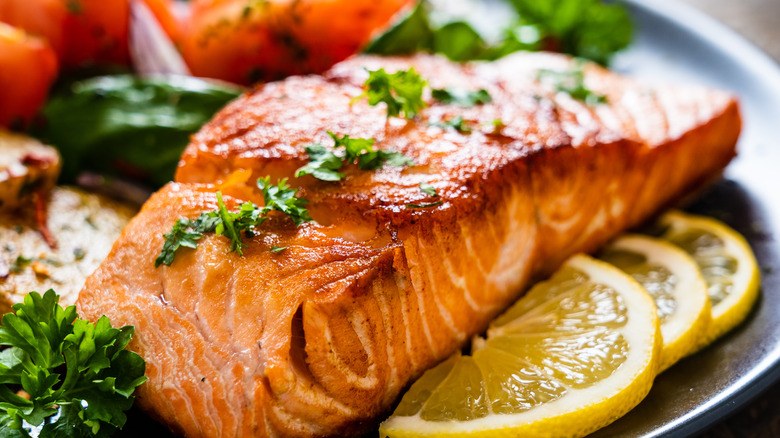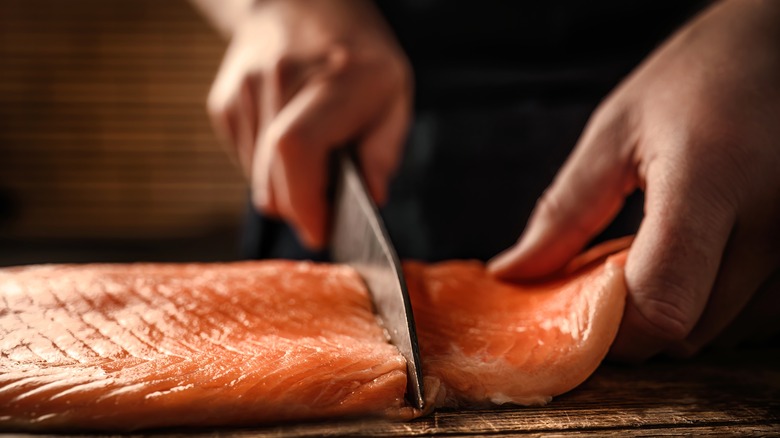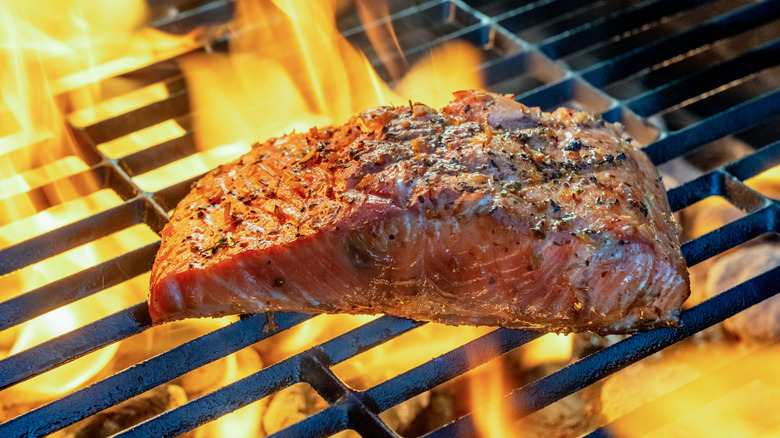Never Eat Dry Salmon Again With A Simple Brine Tip
Despite its status as the second most popular seafood in the U.S., cooking salmon still vexes a lot of home cooks. The pink, oily flesh is dense enough to sear or grill, like a burger patty, but it's easy to overcook and can often come out dry. To avoid your salmon getting too dry, take a page from restaurant chefs and try brining the fish. Brining the filets before they're cooked helps keep the fish moist and flaky after it's cooked. You don't need to follow a complicated recipe to get restaurant-quality results at home. All you need to do is make a simple saltwater brine and plan to prepare your fish about 30 minutes before you want to cook.
Brining sounds fancy, but it's simply soaking your salmon in a salty solution. The brine will do three important things: Season the fish, lock in the moisture, and cut down on the whitish-gray stuff that forms when salmon is cooked.
Make a simple brine
Making a saltwater brine for your salmon is easy. It's a common technique used for meats that tend to dry out easily, especially Thanksgiving turkey because it almost guarantees that it will come out nice and juicy. In the case of salmon, you don't need a laundry list of ingredients to make the brine, just a few tablespoons of Kosher salt and regular old water will get the job done.
Depending on how much salmon you plan to cook, mix about 5 tablespoons of salt for every 3 cups of water to make a simple brine. You'll need enough brine to completely cover the fish so that the salty solution infuses every part of the meat evenly. Hot water will dissolve the salt faster, but make sure you cool the brine down before adding your fish so that it doesn't start to cook the outer layer. Once the brine is ready, drop in the fish and let it soak for 15 to 45 minutes. The longer you brine, the saltier the fish will become, which isn't good for delicate fish, so there's no need to soak the meat overnight like turkey.
Use some pickle juice
While the fish is swimming around in brine it's getting seasoned, but the salty water is also reacting with the surface to create a barrier that holds moisture inside the meat. The salt breaks down some of the protein on the outside of the fish so that moisture can't escape when it's time to cook.
A simple saltwater brine is not hard to make, but if you want to add extra flavor and save a step, use a brine that's probably already in your refrigerator – the liquid from pickles, olives, or other pickled vegetables. These brines are already perfectly balanced, so you don't have to do any measuring before you use them, plus they're already flavored with garlic, dill, and other spices, which can bring a little something extra to your salmon. If you're only cooking a filet or two, a leftover jar of brine is perfect for a weeknight dinner. If you've got a lot of fish to cook, you can make a bigger batch of brine with salt and water, and add the olive or pickle brine into the mix for extra flavor. Once your salmon is done brining, all you have to do is take it out of the solution, pat it dry, and cook it according to your recipe.


